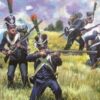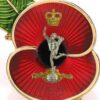Napoleonic Artillery
Home › Forums › Historical › Black Powder › Napoleonic Artillery
- This topic has 12 replies, 7 voices, and was last updated 4 years, 2 months ago by
 Legere.
Legere.
-
AuthorPosts
-
August 12, 2020 at 5:46 am #180615
 RichardParticipant
RichardParticipantHow do you represent artillery in BP, in my old WRG days one gun figure equals to two guns. Is it right that in BP one gun figure equates to a half battery and that 2 gun figures equates to a battery? How does this refer to sections as well?
Thanks in advance for any info.
August 12, 2020 at 7:10 am #180616 Big AlParticipant
Big AlParticipantIs it right? Not really. That is some players’ opinion. The rules only specify that one gun is one gun. Some complain that the size of the base for artillery is too small and insist that the unit should consist of two guns and be increased accordingly. However, that is just opinion, not the rule, although the supplements do suggest similar, they are just suggestions and not rules.
Now, as to what you should do. That is up to you and your opponents to decide. We tend to use single gun models at our club. What I will say about it is that you have to be careful about the changes that you make because it can unbalance things, although, if both sides are doing the same thing, it matters less.
Artillery is very fragile. If it is contacted in Hand to Hand combat, it is lost. If it is Horse Artillery, it becomes almost useless if it takes a casualty – a unit that is shaken cannot advance on the enemy, which means that the Horse Artillery are stuck at their current range and if they retreat, they can’t go forward, which effectively reduces their range and effectiveness. Increasing the unit frontage makes artillery more vulnerable. When charged, like all units, they can shoot at the chargers. If the frontage is increased, the artillery (now with two guns) still only get the three shots that one model gets.
Further, the increased unit frontage (and this is why I think players like it) means that there is less chance of bringing a second unit into the fight when they charge the artillery. If you are charging a single model, any adjacent unit will be contacted and included in the combat. That means additional Closing Fire attacks and additional HTH attacks from the enemy, reducing your chance of success – artillery can’t be supported. I said it was fragile, which means it can be ganged up on and easily destroyed. However, you can place it next to an infantry unit to help to protect it. Increasing the frontage strips it of this protection. Nobody ever mentions this when talking about artillery basing, instead they babble on about the “area” that artillery should cover, conveniently forgetting that it is reflected in the rule that it cannot be supported.
Unless you provide limbers, your Artillery will be manhandled. That restricts the movement to a single 6 inch move, regardless of how successful your command roll is. Some, including the supplements, suggest restricting Horse Artillery’s ability to limber and unlimbers in the same turn, totally ignoring the fact that it only has a stamina of 1.
So, read the rules on the artillery and decide what you want to do. Personally, I don’t understand why players are so keen to make artillery so ineffective in the game. I suspect that they don’t like dealing with it. I mean, yes, it has a nasty sting, but it can’t fire overhead without some serious restrictions and it requires line of sight, naturally, which gets blocked quite quickly, even on a large table.
August 13, 2020 at 12:54 am #180651 Garry WillsParticipant
Garry WillsParticipantSorry big Al, but one of the improvements in BP2 is that they addressed this issue. On p.17 the rules discuss using two or three guns in a unit rather than one. The unit is described as a battery and given the frontage of a small infantry or cavalry unit, 120-150mm. How many real guns is represented by the unit is left open. However the gun scaling needs to change with the size of the infantry units represented by a standard unit. For example in Glory Hallelujah, 4 guns are a normal 3/2/1 unit, with standard infantry battalions at around 400 men.
Regards
Garry
August 13, 2020 at 6:02 am #180653 SteveTParticipant
SteveTParticipantThe thing I found curious was Big Al saying “a unit that is shaken cannot advance on the enemy”. I’ve looked for that under shooting and hand combat. Can’t find it. It’s a game changer. I can find “shaken can’t charge” is all.
August 13, 2020 at 6:35 am #180654 Big AlParticipantAugust 13, 2020 at 7:20 am #180657
Big AlParticipantAugust 13, 2020 at 7:20 am #180657 Big AlParticipant
Big AlParticipantEdited my last post with page numbers.
August 13, 2020 at 8:07 am #180658 invisible officerParticipant
invisible officerParticipantBP is a very flexible minded system. If you want a single model to represent a battery, do it. Or try some ways. My Napoleonic forces have 1 model batteries, my Crimean war forces a 1 model ~ 2 real gun system. Allowing to show the different numbers of guns n batteries.
The front of a battery was wide, the guns not standing wheel by wheel. There was enough space in a battery to let other troops pass through. But also making them a weak close quarter fighting force.
A bigger problem of space was the depth. Gun. Gun limber. 1st amo wagon. With 4 – 6 horses each. Taking more space than an average foot battalion. But a lot of space between the parts.
In BP many play with the manhandled small gun, not the 12pdr. Even 8pdr / 9pdr guns are rarely used without all the stuff. Even the 3 – 6 pdr. batallion gun was drawn by horses. Manhandling gives a very limited amo supply. Only the mini amusette was drawn by men. A big shotgun…….
August 13, 2020 at 9:25 am #180660 Garry WillsParticipant
Garry WillsParticipantThere is a big difference between shaken units not being allowed to charge and not being allowed to advance on the enemy. I am very surprised Big Al you are usually more precise than this. As to my previous post I was reacting to your comment that ‘the rules only specify that one gun is one gun’, which is clearly no longer true.
All the best
Garry
August 13, 2020 at 9:34 am #180661 NatParticipant
NatParticipant@Big Al – that page number tells me shaken units cant charge, not that shaken units cant advance towards the enemy… I dont see how they are the same thing? And as SteveT says its quite a difference.
Advance towards the enemy = make a move and end up closer to the enemy than they where before they moved…
charge = move in to hand to hand combat with the enemy
August 13, 2020 at 11:02 am #180662 Big AlParticipant
Big AlParticipantSorry guys, you are right. Shaken units can advance, they just cannot charge. My mistake!
January 3, 2021 at 3:58 am #183630 LegereParticipant
LegereParticipantBig Al’s post said “Further, the increased unit frontage (and this is why I think players like it) means that there is less chance of bringing a second unit into the fight when they charge the artillery. If you are charging a single model, any adjacent unit will be contacted and included in the combat. That means additional Closing Fire attacks and additional HTH attacks from the enemy, reducing your chance of success – artillery can’t be supported. I said it was fragile, which means it can be ganged up on and easily destroyed. However, you can place it next to an infantry unit to help to protect it. Increasing the frontage strips it of this protection. Nobody ever mentions this when talking about artillery basing, instead they babble on about the “area” that artillery should cover, conveniently forgetting that it is reflected in the rule that it cannot be supported.”
There being no figures on a table or a diagram I’m struggling to visualise this. Are you saying that if a battery is modelled by one gun with a friendly infantry battalion to one or both flanks, if the battery is charged by an infantry battalion in line that battalion must contact one of the flanking battalions too so will take fire etc. whereas if the battery is as wide as the attacking battalion then only the battery will give closing fire etc.?
January 3, 2021 at 6:35 am #183631 Big AlParticipant
Big AlParticipantLegere, that is correct. The rulebook has a couple of diagrams showing the situation and states that maximising frontage means that you cannot avoid contacting two units when one is a single model artillery piece alongside an infantry unit. However, increasing the artillery frontage and means that the you are unlikely to contact both the artillery and the infantry that is adjacent to it.
January 6, 2021 at 2:40 am #183650 LegereParticipant
LegereParticipantOK, got it thanks. Very good point it is too. We will be playing a few systems, though mostly BP, and the 15mm infantry will be based 8 figures in two rows to a 40*30 mm base with two bases to a battalion, the frontage is thus 80mm. I had planned to model a battery using two guns on 40*40 mm bases making a battery also 80 mm wide, given a battery had roughly the same frontage as an infantry battalion. The lack of protection as a result of doing this would clearly increase the vulnerability of artillery even further, though I suppose once infantry are in charge range the artillery is likely toast anyway.
The other issue I suppose is how far do you take this frontage argument? 20-30 years ago I recall folks being VERY hung up on frontages whereas rules these days seem to lean more towards being more ‘representational’, focussing more on effect and a playable game system than accurate geometry. I used to try to model the frontages of battalions and cavalry regiments accurately, getting quite pedantic at times, but of course it all falls down as soon as you start to consider were all the units at EXACTLY the same strength, in EXACTLY the same formation etc etc. In hindsight it was probably pretty pointless.
Now I don’t bother. I use the small, standard and large unit sizes just for the footprint and manoeuvre implications but other than that, infantry is as described above and cavalry are also two bases of 40*30 mm with 3 on each. Given our lack of ‘accuracy’ with regard to infantry and cavalry unit frontages I do wonder if there’s any point getting hung up on the frontage of just one unit type, e.g. artillery, particularly if it’s at the expense of disrupting how it is ‘designed’ to be represented and used in the game, as you say, it unbalances things somewhat and means that infantry cannot really protect artillery at all (I know they can’t support as such but they could give closing fire if they were to be unavoidably contacted too – at least I think). One benefit of using just one gun per battery would be that my 4 current foot artillery batteries become 8 LOL.
As was mentioned above, BP2 includes the option on p.17 to model batteries with more than one model but suggests that unit frontages should be the same as a small infantry battalion. By unit I’m assuming it means the whole battery. This would I think allow the use of greater numbers of guns if using a higher figure count than we are, perhaps for 28mm figures. With our basing though we plan to have a small battalion as 1 x 40*30 base, standard and 2 x 40*30 and large as 3 x 40*30. As such our unit frontage should be 40 mm anyway so that would take us back to square one, one gun per battery it is 🙂
-
AuthorPosts
- You must be logged in to reply to this topic.
